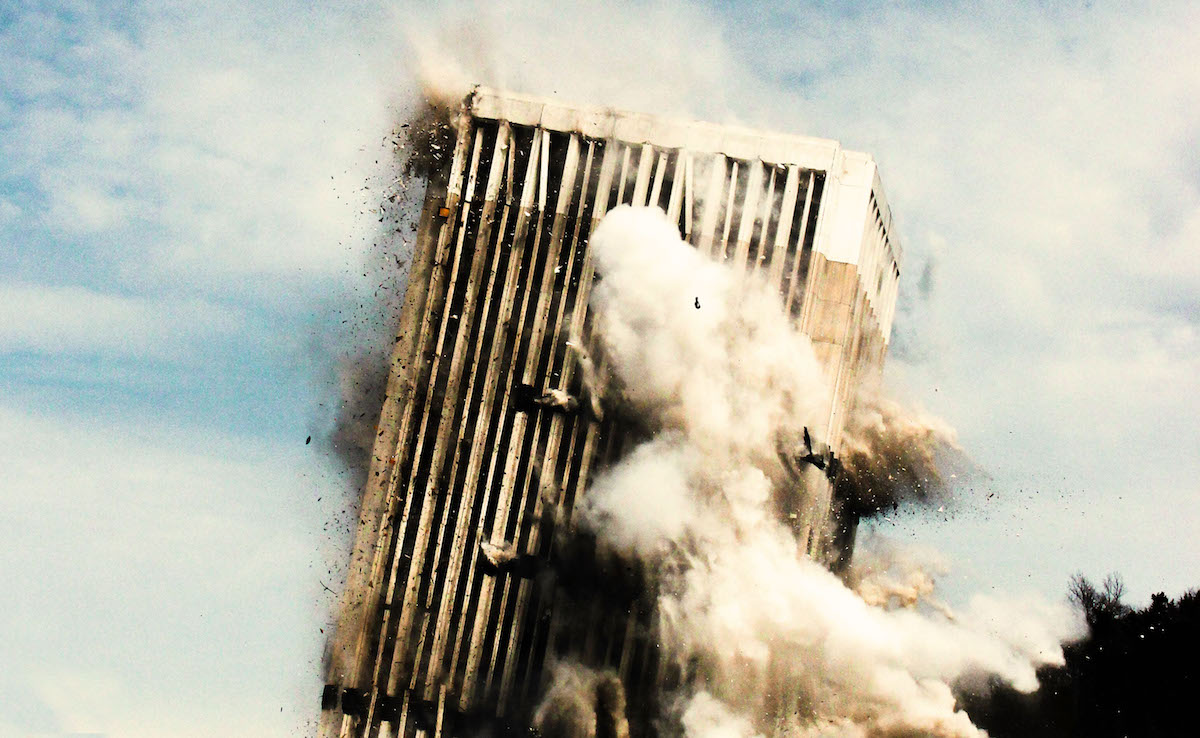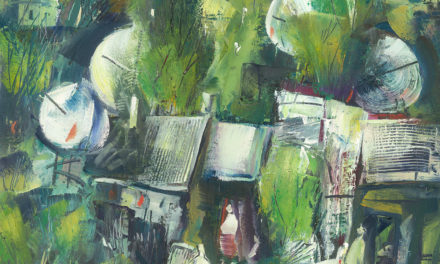Resources and Revolution, Changing the Script on Climate Change
by Meera Velu
Issue 4: Faith | 1,965 words

©Micha Williams
A distinct haze overlaid the interior of a dimly lit theater space. I was seated there in wait of a performance—Mad Max, told through ballet. As I gazed on in anticipation, a peak to stage left revealed what had been producing the ethereal setting—a fog machine. Theater performances for centuries have used smoke and fog to set atmosphere, from the Globe Theatre in the 17th century to New York City nightclubs today. It’s what makes the witches’ brew that much more wicked in Macbeth. That night, the fog seemed placed out of mockery rather than mood. It had been more than five months since the Intergovernmental Panel on Climate Change (IPCC) published their report on the state of our environment. It felt as if I hadn’t yet blinked since reading its damning words; we have a mere twelve years to change course before we see catastrophic climate change. The mimicry of a natural element struck me as incendiary.
Even then, the IPCC’s findings came as little surprise. For more than thirty years now, we have been well informed of our actions and their impacts on the environment; IPCC’s own history confirms this. In 1988, After numerous scientific studies released in the presiding years, the United Nations passed a resolution establishing the IPCC to support research into all causes of climate change and to call upon all governments to “collaborate in making every effort to prevent detrimental effects on climate and activities which affect the ecological balance.”1
That UN resolution undergirded work in other parts of the globe. Earlier in 1988, a panel of scientists, including Dr. James Hansen, the director of NASA’s Goddard Institute for Space Studies, testified before the U.S. Senate’s Energy and Natural Resources Committee. The panel reported a warming pattern in the global climate linked to an increase in carbon dioxide—carbon dioxide that had emerged from human activities, such as the burning of fossil fuel. 1988 saw a record break in warm temperatures.
Immersed in the foggy theater nestled in San Francisco, I was well removed from warmth. The night marked another wet evening in the year’s atypically rainy winter, and the IPCC report continued to haunt me. In the time after its release, media I had sought for enjoyment began to relay sinister messages. In the film “Lucky,” directed by John Carroll Lynch, a seemingly innocuous line about a pet tortoise resonated too sharply—a reminder that human impact on the world is one of devastation (see sixth mass extinction). Aware of Mad Max’s backstory, I dreaded the disconcerting messages the coming performance would reveal. Mad Max has its roots in a 1979 film written by George Miller and Byron Kennedy. The creators based the film off the concept of peak oil and envisioned a chaotic dystopia fueled by that resource’s disappearance. The initial 1979 Mad Max was so successful that it spurred two sequels, a contemporary reboot, and now a ballet. All renditions examine the workings of a world driven to extremes in hunger for key resources.
As the lights lowered, my thoughts turned to our world at present. I wondered how we had come to teeter at this point of no return. 2017 ranked as the second warmest year on record. After years of evidence pointing to human activities and climate change, why did people continue to act in antagonistic opposition?
“Time for me means the dissolution of matter. The rotting of the organic…”
–Clarice Lispector, A Breath of Life
Humans rely on stories; narrative guides our understanding of the world. Unfortunately, not all narratives suit us. While research has strongly correlated human-generated carbon dioxide emissions to a global greenhouse effect, debate on the cause of warming temperatures endures. Some of the disagreement on climate change results from alternative research, funded by the industries directly linked to carbon emissions. From 2000 to 2016, fossil fuel businesses spent $2 billion dollars in the United States on lobbying interests alone. That money does not include publicity expenditures and research funding.
While we like stories, we also seek out those that validate our lifestyles and vindicate our personal rhetoric. Confirmation bias has followed us through history. In an undercover operation, Greenpeace members posing as consultants to fossil fuel companies approached prominent scientists to commission articles favorable to the industry. One of these scientists, Princeton physicist William Happer, graciously accepted money to publish a study with conclusions pointing to carbon dioxide emissions’ supposed beneficial effects. Happer openly admitted that his study would likely not pass through the scientific review standard, upon which he suggested an alternative of “handpicked reviewers” in order to fast-track publication.
“There is such a thing as the burden of proof.”
–Douglas Adams
The Greenpeace sting exposes a tactic fossil fuel industry titans have used for decades to build support for their practices. The strategy succeeds because it helps maintain a status quo. An individual residing in a coal dependent region, for example, is less likely to support notions of human generated climate change because to address the concept and coal’s role would be structurally infeasible. Our industrial society relies upon certain sources of energy, e.g., petroleum, that have only recently become contentious.
Similar to the coal-bound man, a voter who has followed the same political party line without fail will typically continue. Disturbingly, as cited earlier, certain industries wield heavy influence through funding. Money talks. Even a party that vocally supports action to prevent climate change may house members who act in contrariety.2 There are certain leaps of faith we make in life. If a system has never failed us, there is no reason to question it. With climate change, impacts are neither immediate nor direct, which conveniences denial of its existence.
Returning to the performance, as the dancers toed in the light mist, I turned my attention instead to the audience, whose members were enmeshed in a different reality, engaged in a story partially outside themselves. The Mad Max universe enthralls viewers; its main theme, survival in the unknown, remains classic. Mad Max: Fury Road, released in 2015, earned $378 million worldwide, becoming the franchise’s highest-grossing film. Fury Road, following the previous films, depicts a future of water scarcity—a situation not too far from reality in many places of the world. In this reflection, I couldn’t help but recall a recent visit I had made to Mumbai, an Indian city that recently suffered water shortages.
The purpose of my visit late last year was to see my good friend Jonas. I had just flown out of uncharacteristic smog in Northern California, a result of Camp Fire, the most destructive wildfire in California history. The air in this city was also thick, not just from the smug exhale of 860,000 cars—the daily number of cars on Mumbai streets—but also from an unease. Jonas worked as a steward of environmental sustainability business initiatives, and he was similarly burdened by recent climate reports.
In our time together, we roamed through the city’s humid streets and relayed our anxieties to one another. At one point, I asked his opinion on the value of speculative fiction in exploring climate change. I, for obvious reasons, hold strong investment in fiction’s power. Narratives often act as guides for belief and behavior, and I saw fiction as a productive forum to engage larger numbers in the climate change discourse. To find example, we began naming works, starting with Joon-ho Bong’s film Snowpiercer and moving to classics like H.G. Wells’s The Time Machine. Destruction defined each work we named. With climate change so prescient, the inherent doom put us in a state of unease. Could speculative fiction narrate a world outside of catastrophe?
In her Academy Award acceptance speech, Fury Road costume designer Jenny Beavan commented, “it could be horribly prophetic, Mad Max… if we don’t stop polluting our atmosphere… it could happen.” Speculative fiction no longer becomes an escape when reality reflects the fantasy more and more each day. Following the dancers’ spastic movements in disquiet, I returned to that question I had posed in Mumbai. Speculative fiction has sometimes uncomfortably presaged our lived present. In Lilith’s Brood, Octavia Butler details a time on Earth when plastics constitute almost every tangible good, from appliances to clothing, to an unhealthy effect.
While the future appears as a prevalent story element in speculative fiction, the genre is equipped to present all that is possible. Speculative fiction can reenvision history as much as it can forecast a future. In this moment of climate crisis, it is crucial to play with those possibilities. Individuals’ beliefs and opinions on climate change correspond to regional, political, and religious allegiances—a variety of cultural identities. The link to multiple identities allows us to broaden the narrative. If the urgency of our situation can be communicated in a way that resonates with more numbers, perhaps we can move forward sustainably.
Which of our identities is salient depends on the context in which we find ourselves, on the story in which we are engrossed.
–Emily Pechar and Frederick Mayer, “Identity and Climate Change”
As I had discovered in my brief reflection in Mumbai, apocalypse runs rampant in speculative fiction. Readers have gained fast fluency in the subgenre throughout the years with older works like William Hope Hodgson’s The Night Land and Pierre Boulle’s Planet of the Apes (original French, La Planète des Singes) to the current surplus of young adult dystopia, such as The Hunger Games and Divergent franchises. While entertaining, calamity also paralyzes.
Fortunately, a dying Earth does not define speculative fiction. This is a call to writers to use the genre for its strengths. Be inventive! Do not write what’s easy—which has been destruction and man’s supposed genius to overcome it (see Andy Weir’s The Martian, which uses a series of convenient plot devices to find human salvation; or also almost every Star Trek episode). Let’s start fresh and imagine a future, or present, founded upon our care.
Especially with disaster becoming ever more present (2018 experienced even more extreme weather and natural disasters, with catastrophic fires in California and scorching temperatures in Australia and Pakistan to torrential rains in Japan, Nigeria, and India), it takes real imagination to narrate ways that we avoid our planet’s—and our—demise.
Every writer benefits from a prompt at times: with multiple identities working for and against climate change, narrate the climate crisis in a consumable fashion across different cultures and identities. As writers, use the power of storytelling to merge narratives across different groups toward the same goals. Let’s not demonize. Each of us holds responsibility, so write in a way where we can hear one another. These challenges are opportunities.3
Forget Mars, how do we terraform Earth?
For further reading:
Kolbert, Elizabeth. 2006. Field Notes From a Catastrophe.
Pechar, Emily and Frederick Mayer. “Identity and Climate Change.” Presented at Bridging Divides: Spaces of Scholarship and Practice in Environmental Communication The Conference on Communication and Environment, Boulder, Colorado, June 11-14, 2015. Available at: https://theieca.org/sites/default/files/conference-presentations/coce_2015_boulder/pechar_emily_mayer_frederick-542742353.pdf.
Streeby. Shelley. 2018. Imagining the Future of Climate Change: World-Making Through Science Fiction and Activism.

Meera Velu
Meera Velu is one of the founders and editors of Speculative City.




